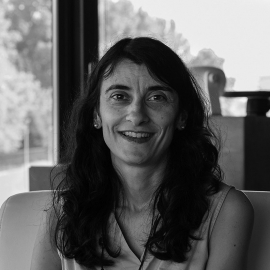Carla Silva is the Program’s Area Director for Nanotechnologies in Portugal. She is the Director of the Department of Chemistry and Biotechnology at the Technological Centre for the Textile and Clothing Industry of Portugal (CITEVE), Portugal. She has vast experience in implementing nanotechnological and biotechnological processes for the textile, automotive, medical, and construction industries.
We challenged her for an interview. She talked about her research interests, her hopes for science’s future, and her interests in technology transfer.
Your first degree was in Biological Engineering. You then went on to do a PhD in Textile Chemistry. How did you become interested in these fields? Why textile chemistry?
Since I can remember, my favourite topics at school were Biology and Chemistry, especially related to the environment and natural organisms. I always wanted to understand how things were made. Therefore, choosing a degree in Biological Engineering allowed me to further explore these topics in an engineering environment, which was the perfect combination. I had then the opportunity to perform my final graduation project and training at CITEVE – The Technological Centre for the Textile and Clothing Industry of Portugal – where I had my first contact with the Textile Industry. After this training, I was invited to work at CITEVE as a superior technician, and this was the spark that triggered my need for furthering my knowledge in the field of chemistry directly related to textiles.
Although Textile Industry is usually seen as a traditional industry, it is, in fact, very innovative. For example, it was the first industry to use enzymes in its processes on an industrial scale more than a hundred years ago. It is still, however, to this day one of the most polluting industries due to its high energy, water, and chemical consumption. This was also a trigger in inspiring me to develop more sustainable processes for this sector as well as motivating me to do my PhD in the field of Textile Chemistry.
More recently, you’ve been working with nanomaterials and smart materials. What’s a smart material, and what excites you the most about these technologies?
Although there is no standardised definition for smart materials, it is widely accepted that a smart material is a material that changes one or more of its properties in a controlled way by application of external stimuli, such as pressure, moisture, electric or magnetic fields, light, temperature, pH or exposure to chemical compounds. These materials are also called intelligent or responsive materials, having an important impact on many products we use in our daily lives. A simple example could be a tea mug that changes colour when it’s hot due to the presence of thermochromic pigments or a smartphone display that auto repairs its cracks due to the use of self-healing polymers.

The possibility to transform a simple object into an intelligent and responsive object, able to repair itself or alert us to a possibly dangerous situation, is extremely challenging. Finding new smart materials and new innovative applications for these is one of the most exciting areas within the nanomaterials and smart materials fields.
You did your master’s degree in Brazil. Was this the first time you went on to study abroad? How did this experience influence the researcher you are today?
Before enrolling in my PhD, I did my master’s in Brazil. I’ve always wanted to study abroad, and at the beginning of the ’90s, this was not easily accomplished since Erasmus projects were at their very beginning, and there were no scholarships available for master’s degrees in Portugal. When I heard about the opportunity to apply for a grant for a Master’s in Industrial Biotechnology at the University of S. Paulo, I knew it was time to take on that challenge.
The master’s program complemented my degree in Biological Engineering well and allowed me to explore the development of industrial biotechnological processes. More precisely, the ability to use microorganisms to produce chemical compounds from agro-industrial residues to replace synthetic materials for industrial applications was opening my field of research and widening the potential for developing sustainable materials and processes with a strong impact in the environment, having a strong influence in all research projects in which I am engaged.
You have more than 20 years of experience in applied and industry-oriented research, but you have also worked tirelessly in academia. What is the most rewarding part of working with both the industry and academia? And what’s the worst part?
Having the opportunity to work in applied and industry-oriented research is the most rewarding part of my work. Indeed, in this scenario, we are very much focused on practical questions and in the effective transition to a higher technology readiness level (TRL), enabling quicker market proofing. Very often, we see some of the products we helped develop being commercialised, and this is exciting. Usually, a limitation when working together with industry and academia is the necessity to speak the same language, being this fact of paramount importance for a common understanding. And being in both circles allows me to bridge effectively between these two worlds, increasing the final impact of the research and allowing it to eventually follow its path to the market. This is, without a doubt, the most rewarding part of my work.
I would be tempted to say that the worst part of working together with industry and academia is managing expectations and the setting of goals and priorities since for academia maximising publications and knowledge dissemination is the main goal while industry works mainly in the opposite direction, trying to keep the knowledge as secretive as possible.
You currently have ten patents. What makes you a fan of technology transfer? Why dedicate so much of your time to taking technology into the market?
Doing research with a clear, practical application in mind is really rewarding, in particular when there is a possibility to transfer the generated knowledge to a company that could eventually explore it to generate profits. Although patenting is still not a priority for most Portuguese companies, we see a significant change in this mindset, and several companies already understand the value of Intellectual Property protection and the importance of technology transfer. An important topic is that this knowledge sharing must be aligned with the principle implemented by the European Commission: “as open as possible, as closed as necessary” to encourage data management since the project’s beginning as an essential part of practical research.
What do you think is the biggest threat to science today?
The way information is shared and the impact and importance of social media in today’s society is putting high pressure on reliable scientific knowledge communication and constitutes, in my view, the biggest threat to science.

The recent pandemic highlighted not only the way information is manipulated by social media to the interests of specific groups, including political and economic players, but also the danger and complexity in transferring reliable information, essential to scientific and technological progress. Indeed, the complex social network and social media in particular, including algorithmically driven search and click-based advertising, has changed the way that people get information and form opinions about the world in a way that makes people particularly vulnerable to the spread of misinformation and disinformation.
During your professional journey, how and when did the UT Austin Portugal Program appear?
The Program was introduced to me about three years ago, during the implementation of the second stage of the UT Austin Portugal Program, where I was invited to take part in the Program, as coordinator of the Nanotechnologies area, together with Brian and Paulo. My solid experience in working with nanomaterials and smart materials for higher TRL levels and more practical applications, as well as my previous experience as CTO of the Centre for Nanotechnology and Smart Materials (CENTI), was the motivator to participate in this Program, where more focused research was desired.
What are the highlights of your journey with the Program?
I could name several, ranging from the excellent network of talented researchers in the nanomaterials field, both in UT Austin and in Portugal, that we get to know and work with, to the excellent coordination of the Program and the way the Program is set to create impact in several key research strategic areas for Portugal. I would, however, underline the effective collaboration between researchers from both countries. The opportunity given by the Program to the exchange of researchers enables effective and long-lasting collaboration that would otherwise be difficult to achieve.
Where do you imagine yourself 20 years from now?
We are facing a global climate crisis, with unparalleled consequences for our future and the future of the generations to come. It is time to drastically change the way we are used to doing things; not only from an industrial perspective, where the transition from a linear economy to a circular and bio-based economy is mandatory, but also in the way we acquire the products, use them, and dispose of these at their end-of-life. If nothing is done now, it will be very difficult to maintain life as we know it, and this has been the focus of my research for some time now, and this is what I imagine myself actively doing 20 years from now, helping in the transition into a greener economy. New sustainable and energy-efficient production processes, fully renewable, carbon-neutral and recyclable materials and products and fossil-free raw materials are only a few examples of research areas where scientific and technological advances are needed.
